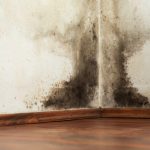Mold is a common yet often overlooked issue in both residential and commercial properties. Understanding where dangerous mold can occur is crucial for maintaining a healthy environment. This article will explore common locations for mold growth, the environmental factors that contribute to it, the types of dangerous mold, health risks, prevention strategies, and frequently asked questions.
Common Locations for Dangerous Mold Growth
A. Residential Areas
- Bathrooms Bathrooms are among the most common places for mold growth due to high humidity levels and frequent water use. Mold thrives in damp environments, making showers, sinks, and bathtubs ideal breeding grounds.
- Kitchens Kitchens can also be a hotspot for mold, especially around sinks, dishwashers, and refrigerators. The moisture from cooking, combined with food sources, creates a conducive environment for mold growth.
- Basements Basements are typically more prone to dampness and poor ventilation, making them a significant area for mold development. Leaks, flooding, or high groundwater levels can exacerbate this issue.
- Attics Mold can develop in attics due to inadequate insulation and ventilation. Accumulated moisture from roof leaks or high humidity can lead to mold growth, especially in poorly ventilated areas.
- Walls and Ceilings Hidden leaks or condensation can lead to mold growth behind walls and ceilings. These areas often go unnoticed until visible signs appear, making regular inspections essential.
B. Commercial Properties
- Office Buildings In office buildings, HVAC systems can contribute to mold growth if not maintained properly. High humidity levels and stagnant air can create ideal conditions for mold.
- Retail Spaces Retail environments, especially those with storage areas, can accumulate moisture. Wet items and insufficient airflow can promote mold growth.
- Restaurants Kitchens in restaurants are particularly vulnerable to mold due to constant exposure to water and food. Regular cleaning and maintenance are crucial to prevent mold in these settings.
C. Public Spaces
- Schools Schools can experience mold growth due to water damage, poor ventilation, and high humidity levels. Mold can affect both students and staff, leading to health concerns.
- Libraries Libraries can harbor mold due to moisture from books and limited airflow. Proper climate control is vital to maintain the integrity of the collections.
- Hospitals Hospitals have unique conditions that can foster mold growth, particularly in areas with high humidity or water exposure. Mold in these settings poses significant health risks to patients and staff alike.
Environmental Factors Contributing to Mold Growth
A. Humidity Levels
Mold typically thrives in environments with humidity levels above 60%. Maintaining lower humidity levels can help prevent mold growth.
B. Temperature
Most mold species prefer temperatures between 70°F and 90°F (21°C and 32°C). Warm, damp environments provide ideal conditions for mold proliferation.
C. Water Sources
Leaks from roofs, plumbing issues, or condensation from windows can create the moisture needed for mold to flourish. Addressing water sources is essential in preventing mold growth.
Types of Dangerous Mold
- Black Mold (Stachybotrys chartarum) Often cited as the most dangerous type of mold, black mold can produce mycotoxins that affect respiratory health and overall well-being.
- Aspergillus This mold can produce allergens and mycotoxins, leading to respiratory issues, especially in individuals with weakened immune systems.
- Penicillium Commonly found in damp areas, Penicillium can cause allergic reactions and respiratory problems.
- Cladosporium This mold is often found in warm, humid environments and can cause allergic reactions and asthma attacks.
Health Risks Associated with Mold Exposure
Exposure to mold can lead to various health issues and HVAC-associated damage including:
- Allergic Reactions: Symptoms can include sneezing, runny nose, and skin rashes.
- Respiratory Issues: Mold spores can aggravate asthma and cause other respiratory problems.
- Other Health Effects: Prolonged exposure may lead to more severe health conditions, including chronic fatigue and immune system issues.
Preventing Mold Growth
A. Moisture Control
Keeping indoor humidity below 60% can significantly reduce the chances of mold growth. Using dehumidifiers and air conditioners can help regulate moisture levels.
B. Regular Inspections
Conducting regular inspections of high-risk areas can help catch mold growth early. Look for signs of water damage, leaks, and condensation.
C. Proper Ventilation
Ensuring adequate ventilation in bathrooms, kitchens, and basements can help prevent moisture buildup. Installing exhaust fans can be particularly effective in damp areas.
FAQs
A. What are the signs of dangerous mold presence?
Signs include visible mold growth, a musty odor, water stains, and increased allergy or respiratory symptoms.
B. How can I test for mold in my home?
Home mold testing kits are available, or you can hire a professional to conduct a thorough inspection.
C. What should I do if I find mold?
If mold is discovered, clean small areas with appropriate cleaning solutions or consider hiring a professional for larger infestations.
D. Can mold be removed safely on my own?
Small mold patches can often be cleaned safely using proper protective gear and cleaning solutions, but larger infestations should be handled by professionals.
E. When should I call a professional?
If you discover extensive mold, mold that recurs after cleaning, or if you have health concerns, it’s best to call a professional mold remediation service.
Conclusion
Understanding where dangerous mold can occur is essential for maintaining a safe and healthy environment. By being aware of common locations, environmental factors, and preventive measures, you can take proactive steps to prevent mold growth. If you suspect mold in your home or workplace, do not hesitate to take action to protect your health and property.






